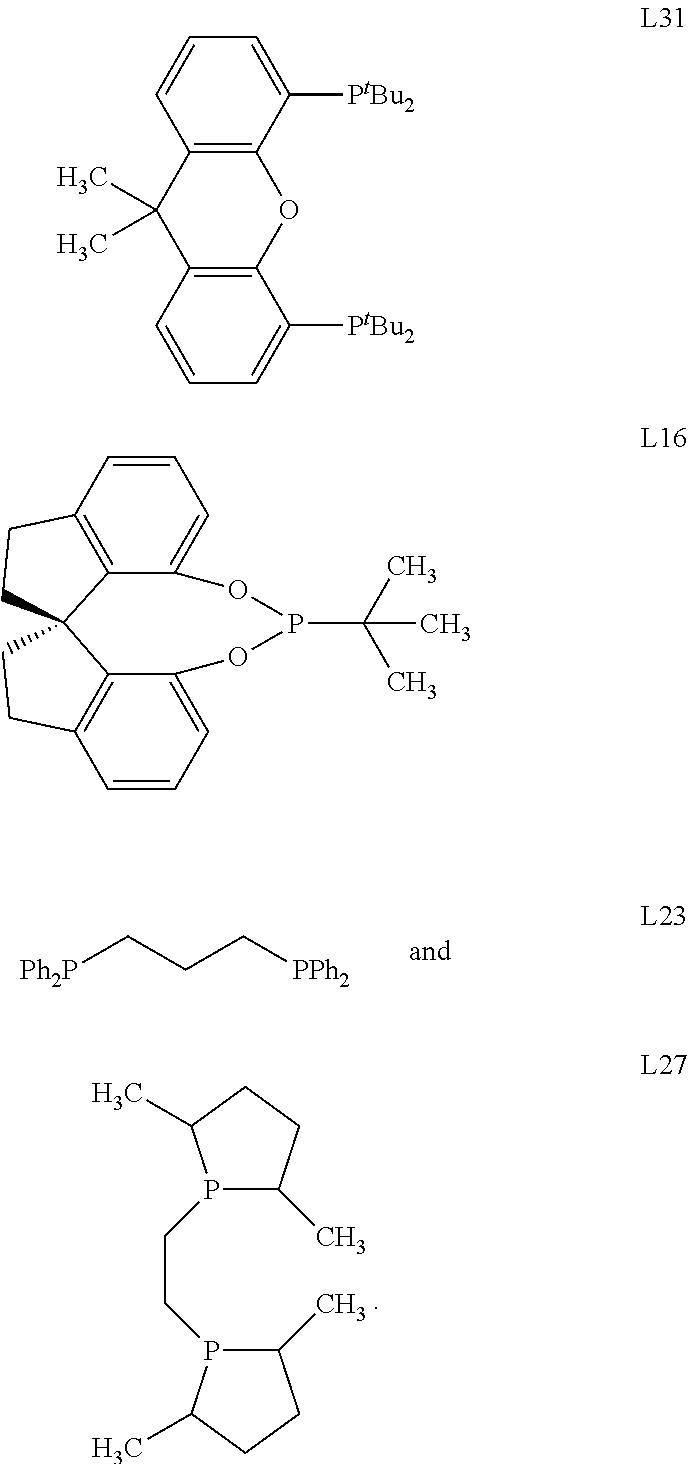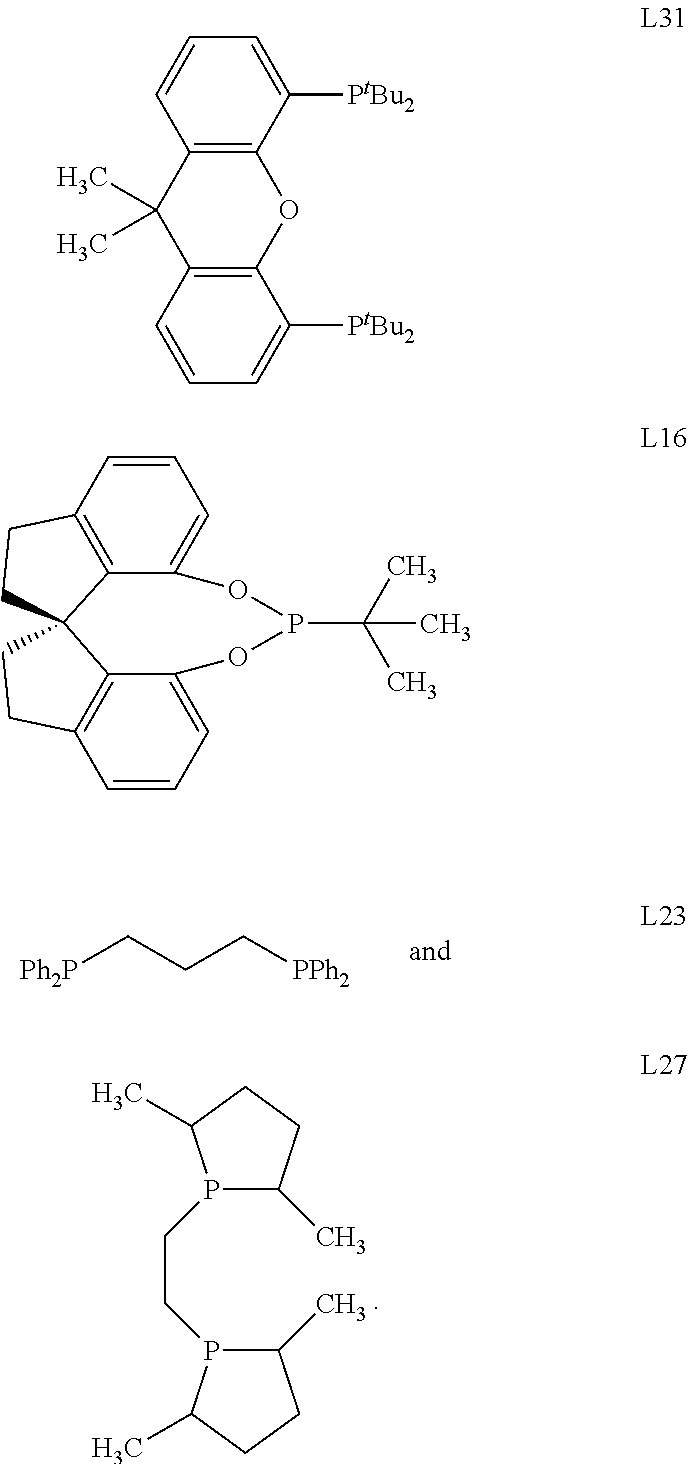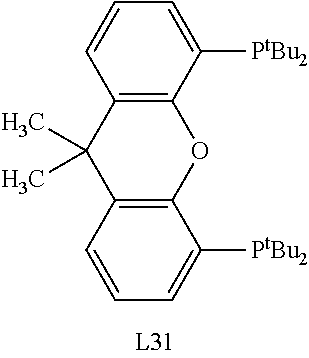Selective catalysts for spinetoram production
a technology of selective catalysts and spinetoram, which is applied in the direction of physical/chemical process catalysts, organic compound/hydride/coordination complex catalysts, biocide, etc., can solve the problems of increasing temperature, requiring a relative high loading of catalysts, and requiring further improvement of yield, so as to improve yield/efficiency, the effect of reducing the loading of catalysts
- Summary
- Abstract
- Description
- Claims
- Application Information
AI Technical Summary
Benefits of technology
Problems solved by technology
Method used
Image
Examples
example 1
[0016]Selective hydrogenation of 3′-O-ethyl-spinosyn J / L (Et J / L) mixture using [Rh(C2H4)2Cl]2—[Rh(C2H4)2Cl]2 (0.1019 grams (g), 0.2620 millimoles (mmol)) is added to a 10 mL volumetric flask, and the flask is diluted to the mark with tetrahydrofuran (THF). The catalyst stock solution is stirred to produce a dark brown, homogeneous mixture. An aliquot of the stock solution (0.500 milliliters (mL)) is added to a solution of Et J / L (8.15 g Et J, 0.0109 moles (mol) Et J and 2.64 g Et L, 0.00348 mol Et L) dissolved in isopropyl alcohol (IPA; 39.5 mL), and the mixture is stirred and then charged to a Parr reactor using a gas tight syringe. The reactor is heated to 30° C. and then pressurized to 60 psig with hydrogen gas. After 4.5 hours, the reactor is vented. By 1H nuclear magnetic resonance (NMR) spectroscopic analysis, 0 g Et J (100% conversion), 8.011 g 175 Et J (98% yield) and 2.64 g Et L (100% yield) are found (TON=404 mol Et J / mol Rh).
example 2
[0017]Selective hydrogenation of 3′-O-ethyl-spinosyn J / L (Et J / L) mixture using [Rh(COD)2][BF4]—[Rh(COD)2][BF4] (0.0175 g, 0.0431 mmol) is dissolved in 40 mL methyl alcohol in a 50 mL jar. Purified Et J / L powder (8.3 g, 0.0111 mol Et J / L) is weighed into a 50 mL volumetric flask, and the flask is diluted to the mark with IPA. Once the Et J / L is dissolved, an aliquot (0.5 mL) of the yellow catalyst stock solution is combined with an aliquot of Et J / L stock solution (2.0 mL) and IPA (2.5 mL). The reaction mixture is charged to a glass test tube in a Freeslate Parallel Pressure Reactor (PPR). The reactor is heated to 65° C. and pressurized to 150 psig with hydrogen gas. After four hours, the reactor is cooled to room temperature and vented. By high-performance liquid chromatography (HPLC) analysis, 0.225 g Et J (19.9% conversion) and 0.0721 g Et L (99% yield) are found (TON=172 mol Et J / mol Rh).
example 3
[0018]Selective hydrogenation of 3′-O-ethyl-spinosyn J / L (Et J / L) mixture using [Rh(COD)2][BF4] and tris(3,5-dimethylphenyl)phosphine—[Rh(COD)2][BF4] (0.0215 g, 0.0529 mmol) and tris(3,5-dimethylphenyl)phosphine (0.0383 g, 0.1106 mmol) (used as a phosphorus ligand donor) are weighed into a 5 mL volumetric flask, and the flask is diluted to the mark with methyl alcohol. The catalyst stock solution is stirred to produce an orange, homogeneous mixture. An aliquot of the catalyst stock solution (0.500 mL) is added to a solution of Et J / L (4.19 g Et J, 5.62 mmol Et J and 1.36 g Et L, 1.79 mmol Et L) dissolved in IPA (19.5 mL) and, the mixture is stirred and then charged to a Parr reactor using a gas tight syringe. The reactor is heated to 45° C. and then pressurized to 150 psig with hydrogen gas. After eight hours, the reactor is cooled to room temperature and vented. By 1H NMR analysis, 0.124 g Et J (97% conversion) and 1.32 g Et L (98% yield) are found (TON=1035 mol Et J / mol Rh).
PUM
| Property | Measurement | Unit |
|---|---|---|
| temperature | aaaaa | aaaaa |
| temperature | aaaaa | aaaaa |
| temperature | aaaaa | aaaaa |
Abstract
Description
Claims
Application Information
 Login to View More
Login to View More - R&D
- Intellectual Property
- Life Sciences
- Materials
- Tech Scout
- Unparalleled Data Quality
- Higher Quality Content
- 60% Fewer Hallucinations
Browse by: Latest US Patents, China's latest patents, Technical Efficacy Thesaurus, Application Domain, Technology Topic, Popular Technical Reports.
© 2025 PatSnap. All rights reserved.Legal|Privacy policy|Modern Slavery Act Transparency Statement|Sitemap|About US| Contact US: help@patsnap.com



